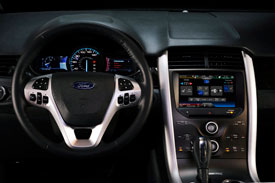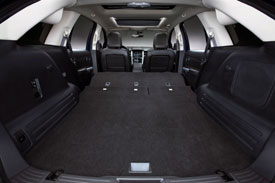2011 Ford Edge
For a brand known for its once top selling body-on-frame explorer SUV, the arrival of the 2006 Ford Edge midsize crossover utility really raised eyebrows. But Ford was just responding to the reality of surging gas prices and a flood of lighter, more efficient CUVs from import rivals. So, the Edge was a gamble that paid off. Now, Ford is doubling down with a mid-cycle edge revamp of the Edge. So let’s see if it’s again a winner.
Typical of what car makers call a freshening, the 2011 Edge maintains most of its exterior sheet metal, with major changes largely limited to front and rear fascias.
But, the addition of a big drop-jaw Ford-truck style grille, more expressive headlamp housings, and beefier wheels, does deliver a fresh impression, and makes the modern stance of the Edge even more so.
But, Ford smartly paid a lot more attention to upgrading the interior of the Edge. The instrument panel is improved in style, in fit and finish, with softer materials. Taurus influence is unmistakable.
Our well-equipped Edge Limited also included the latest Sync system which controls climate, stereo, navigation, and other functions.
Ford’s Sync voice recognition system has now morphed into MyFord Touch and it has three screens: two colorful info screens inside the gauge cluster, and a large touch screen in the center dash. Now it looks very much like a big smart phone display.
 And like a smart phone, there’s no tactile feel, so you have to look at the screen when you actually want to make a touch selection. We find that distracting—and it’s also annoying, especially when the system locks up like it did for us.
And like a smart phone, there’s no tactile feel, so you have to look at the screen when you actually want to make a touch selection. We find that distracting—and it’s also annoying, especially when the system locks up like it did for us.
Now there are redundant controls for stereo and climate below, but they’re very sensitive, so again you have to look at what you’re touching.
On the other hand, Sync’s voice command system and Bluetooth connectivity are improved, but they’re still just a little fussy.
The two gauge screens are controlled by five-way switches on the steering wheel. Of all the controls, they are the most intuitive to use.
Available SD-card based navigation adds some neat tricks, too, like buildings appearing in 3D. But the best news here is the addition of SYNC TDI, an On-Star-like voice-prompt navigation feature.
Systems like Sync and MyFord Touch may very well be the future of automotive controls. Still, we also hope efforts continue to make voice command systems more intuitive, since you don’t have to take your eyes off the road to use those.
Edge remains a five-passenger crossover. The new front seats are more comfortable but could still use more lateral support.
Ford’s unique door keypad is standard on all but base trim. Blind Spot Monitoring is an option.
 Rear seat space and comfort remain excellent, even for six-footers. That still leaves room for 32.2 cubic feet of cargo space behind a large opening hatch. And, folding the seats down brings that space to a competitive 68.9 cubic feet.
Rear seat space and comfort remain excellent, even for six-footers. That still leaves room for 32.2 cubic feet of cargo space behind a large opening hatch. And, folding the seats down brings that space to a competitive 68.9 cubic feet.
Base power for the Edge is still a 3.5-liter V6. But it’s smoother, with 285 horsepower, up 20, and 253 lb-ft of torque, up three.
New is the Mustang’s 3.7-liter V6 in the Edge Sport with 305-horsepower and 280 lb-ft of torque.
Front-drive six-speed automatics are fitted to both sixes with Sport trim adding paddle shifters. All-wheel drive adds new Hill Start Assist.
Still to come is an Edge Ecoboost, with a direct-injected, turbocharged 2.0-liter I-4. But, even without Ecoboost, Edge made gains in fuel economy.
Our front-drive 3.5 has government fuel economy ratings of 19 city, 27 highway. That’s up one in the city and two on the highway. On our test loop, we averaged 22.8 mpg of regular.
The Edge’s moderate Energy Impact Score of 15.6 barrels of oil per annum, and 8.5-ton Carbon Footprint, mirror those of the Toyota Venza V6.
Edge track performance was well above par: zero to 60 in 7.1 seconds, and the quarter mile in 15.7 seconds at 93 miles per hour. Power was best in the upper revs.
There was a fair amount of body roll through the slalom, but it had no notable affect on stability. The Edge Sport with its 22-inch wheels does even better.
The all-disc braking system is also new, from booster, to calipers, to first time Brake Assist. Our average 60-to-0 stopping distance of 129 feet was far better than the 146 feet in our previous test. Still, the 2011 Edge exhibited moderate fade and nose dive.
The Edge is a solid long distance highway tourer. Improved sound insulation, including acoustic glass, complement powertrain tweaks for impressively low noise at speed.
Pricing for a base Edge SE starts at $27,995. Our front drive Limited begins at $34,995, and the Sport at $36,995. All-wheel drive adds $1,850 more.
The improvements in the 2011 Ford Edge are extremely well-thought out. More tech, more comfort, and more all-around performance, without compromising its already strong five-passenger utility traits. It’s a perfect pairing for the all-new seven-passenger Explorer due soon. And that will make even more of a competitive edge for Ford’s rivals to worry about.
Specifications
- Engine: 3.5-Liter V6
- Horsepower: 285
- Torque: 253 Lb Feet
- 0-60 MPH: 7.1 Seconds
- 1/4 Mile: 15.7 Seconds @ 93 MPH
- 60-0 MPH: 129 Feet
- EPA: 19 MPG City/ 27 MPG Highway
- Mixed Loop: 22.8 MPG
- Energy Impact: 15.6 Barrels Oil/Yr
- CO2 Emissions: 8.5 Tons/Yr
2024 Polestar 2
More Range And More Power For The Polestar 2
Volvo is well on their way to making the transition to an all-electric brand, but their sister-brand Polestar is already there. Now, we’ve spent lots of time in their all-wheel drive, five-door Polestar 2, having tested it in 2021, and a year later when a two-wheel drive version arrived. But, EV updates are coming quickly. So, let us be your guide for all that’s new with the Polestar 2.
While we are driving more EVs than ever, we’ve also been spending a lot of time recently circling back to ones we’ve previously tested. As in this new era of electrified vehicles, significant updates are arriving quickly, with R&D investments increasing and retrofitting them easier than ever. This is often done through software updates that can even be accomplished over the air. For 2024, the Polestar 2 has indeed gotten some software updates, but some physical ones as well.
Clearly aimed directly at Tesla’s Model 3 when it arrived; the Polestar 2’s build quality was vastly better, but range definitely came up short. So, addressing that was priority No. 1; and for ’24 the Polestar can travel up to 20% farther than before while consuming 9% less energy, and when it comes time to charge it back up, it can do that 34% faster too.
Range in the Single Motor version increases from a max of 270 to 320 miles thanks to a larger 82-kWh battery pack, and that solitary motor now powers the rear wheels, not the front wheels. It’s also bigger, coming in at 220 kW compared to the previous 170 kW front-wheel drive version, going from 231 to 299 horsepower.
Dual Motors keep the same 78-kWh battery, but still sees a boost from 260 to 276 miles and takes advantage of the larger rear motor for a new combined 310-kW output with 421 horsepower. Our test car has the added Performance Pack, which uses an additional 35 kW to deliver 455 horsepower and 546 lb-ft of torque, though max range drops to just 247 miles.
The new battery in rear-drive 2s will also charge faster, now accepting up to 205 kW for an 80% charge in 20 minutes; max for dual-motors stays at 155 kW, which puts an 80% charge at 34 minutes. Using 32 kWh of electricity per 100 miles, the Dual Motor earns a good efficiency rating.
The [Polestar] 2 has always been one of the most enjoyable EVs to drive, even more so now with that additional power coming from the rear motor.
Unfortunately, extremely cold temperatures kept us from seeing that increased range, as we were only on pace for about 194 miles in our test.
The 2 has always been one of the most enjoyable EVs to drive, even more so now with that additional power coming from the rear motor. And especially when equipped with the Performance Pack as it not only includes more power, but adds 20-inch forged wheels, upgraded brakes, and adjustable Ohlins Dual Flow Valve performance dampers. It greatly improves handling prowess without affecting ride quality, and is easily worth the $5,500 charge if you at all enjoy driving.
Even on a 20-degree track day there was plenty of grip through our handling course. No understeer or oversteer, and lots of feedback through the wheel. There was a nice, strong launch off the line that properly planted us firmly in the seat, and rocketed us to 60 in 4.5 seconds. Power delivery stayed pretty intense up until about 80 mph when there was a definite tapering off. Still, it was a 13.4-second quarter-mile at 102 mph; smooth, quiet, and stable the whole way.
When this car debuted, its Google-based infotainment setup was a novelty, but since then, more and more manufacturers are just “Googling it” so it doesn’t seem out of place at all. The wireless phone charger is easy to access, and there’s a great Harmon/Kardon sound system and panoramic sunroof to enhance the in-cabin experience. Exteriors have also been enhanced with a smooth grille insert and new wheel choices.
Hatchback practicality means 14.3 cu-ft of easy to access cargo space with split-folding seatbacks for longer items and expanding the space to 38.7 cu-ft. Plus, there’s even a sizeable storage bin up front under the hood.
Single Motor Polestar 2 pricing now starts at $51,300, with Dual Motors starting at $56,700; topping out at $64,400.
For a car manufacturer that hasn’t even been around for a decade yet, Polestar has kept itself busy, totally transforming their latest model in just a few years, making the 2024 Polestar 2 even more appealing. They are certainly off to a good start, and with a host of Polestars just over the horizon, including some all-important utility vehicles, this star will be shining even brighter.
Specifications
As Tested
- Motor Setup: Dual Motor
- Horsepower: 455
- 0-60 mph: 4.5 seconds
- EPA Range: 247 miles
- Efficiency : 32 kWh / 100 miles
- Battery Size: 78-kWh
- Torque: 546 lb-ft
- 1/4 Mile: 13.4 seconds at 102 mph
- MW Test Loop: ~ 194 miles
- Peak Charging Rate: 155 kW











































